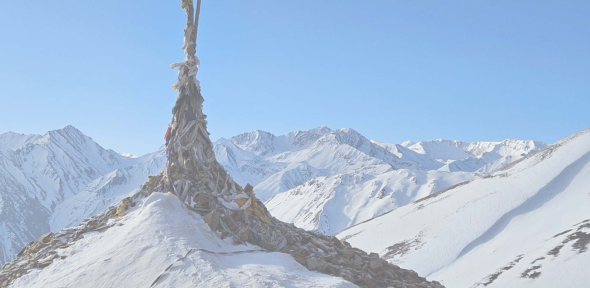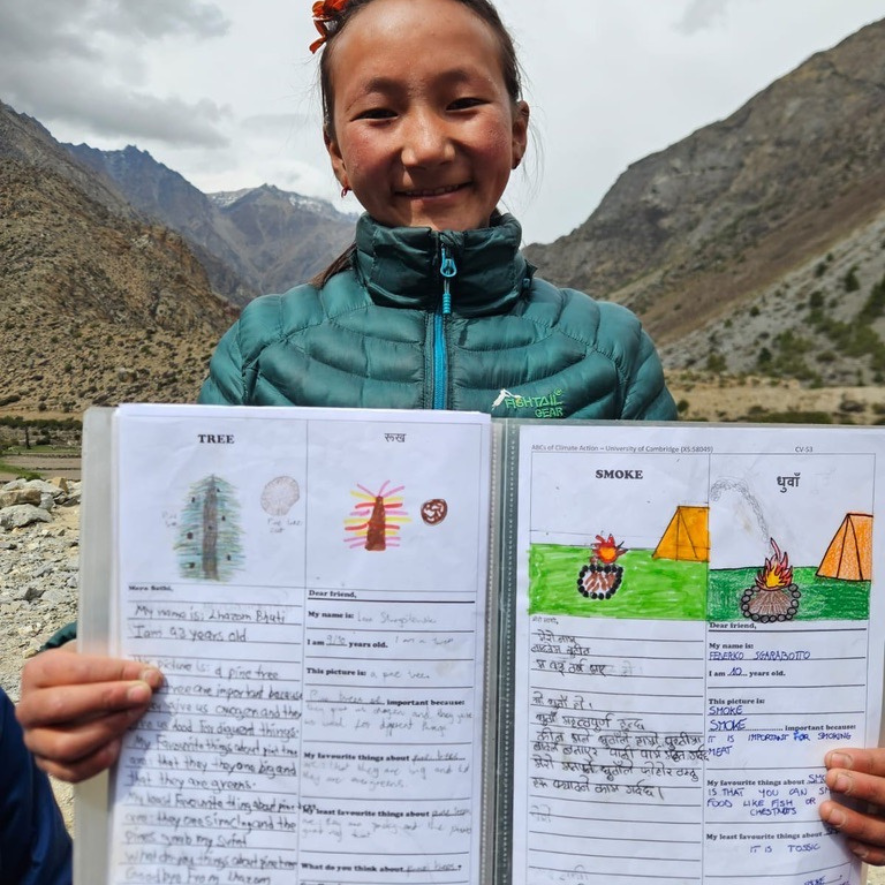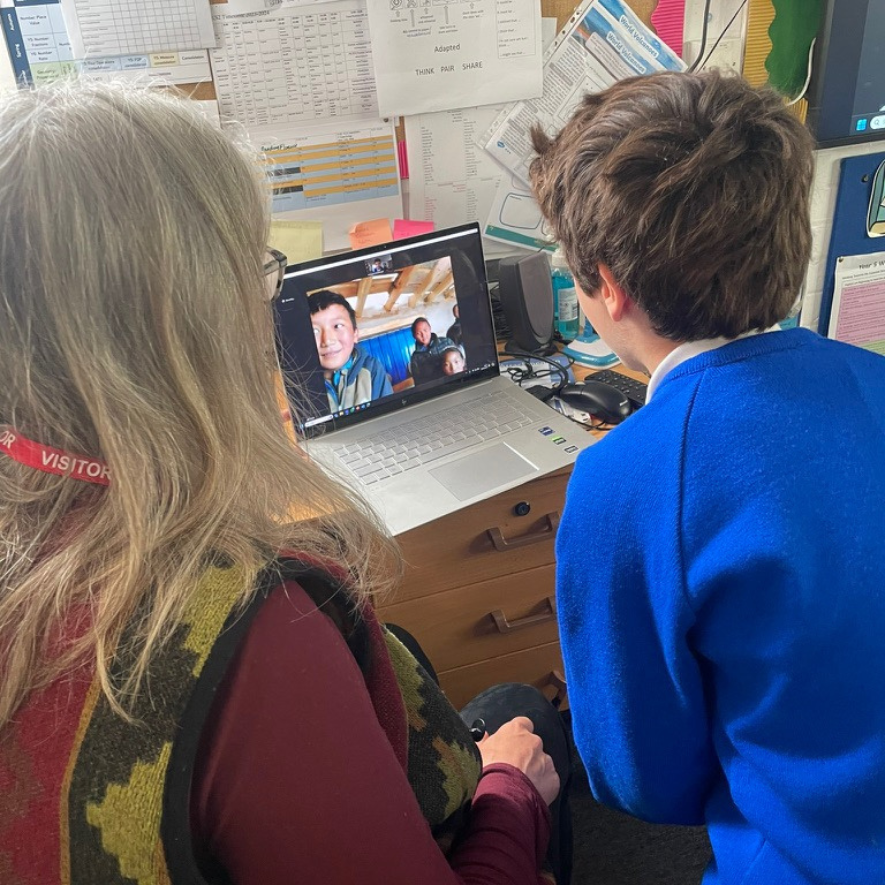
Two ambitious researchers have pooled their collective expertise to develop a very local approach to the global climate emergency.
‘Precipice thinking’ is how social anthropologists Dr Kelly Fagan Robinson and Dr Hildegard Diemberger describe the critical phase reached in their shared research. For the past two years, they have been working with three very different village primary schools in rural areas of Italy, the UK and Nepal to explore climate change and environmental knowledge through children.
Each school had recently experienced extreme weather conditions: a tornado in Caravate, Italy, the first occurrence in the region; lowland flooding in East Anglia; and devastating unseasonal storms, droughts and blizzards in the remote Himalayan valley of Limi, northwestern Nepal, that cut off the villages, resulting in famine and deaths across the region.
“There are many programmes for environmental education,” says Diemberger. “But addressing climate emergencies through this bottom-up approach, building long-term resilience in the younger generation, that is very novel.”
The pair are developing a series of best practice curricula, adapted to geographically specific problems such as increasingly extreme weather as a result of climate change. Not simply imposing scientific method on local people, each curriculum will foreground local environmental knowledge and heritage. In collaboration with national authorities in each location, they are eager to gradually scale up their successful pilots to launch a best practice international toolkit.
Schools as sites of engagement
For Robinson and Diemberger, schools are the frontline in this race to combat climate change, not just to reach the next generation, but because schools are such important community sites. “It’s the institution that people are most likely to engage with,” says Robinson.
“Disenfranchised people – whether in Nepal, Italy or the UK – will engage with schools, not just because they are legally required to do so, but because they want their children to learn. Particularly for recently arrived families in Italy and the UK, it's where they learn language and how they gain access to public services.” Schools become the ‘town hall’ - places to engage the wider community of parents and grandparents.
The team engages children using a method called ABC, or Anthropology By Children, developed and trialled by Robinson in schools since 2021. Following a citizen-science approach – data collection led by the public, in this case children – they teach using well-established anthropological concepts via novel techniques. These encourage creative responses not often drawn out through traditional education.
Photovoice is often used by anthropologists to provide visual evidence when documenting social phenomena. The ABC iteration encourages children to photograph their immediate surroundings, presenting the spaces and things they value and the infrastructures or harmful behaviours they want to change. Proxemic mapping, an activity based on the work of Edward Hall to document power dynamics and hierarchies through bodily positions, teaches children to map their environment, investigating how we use space and what we communicate through distance and closeness. There are games, drawings, or other playful exercises to encourage interaction.
“The children start to realise they already know these techniques,” explains Robinson. “Anthropology is simply recognising what it is to be human and then finding connections. Adults don't always notice these connections, often because they’re so commonplace or they fit institutional expectations.” ABC gives the children the agency to make change happen.
Finding unseen connections
At first glance, these are two researchers with radically different subject expertise.
Guided by her alpine upbringing in the mountains of Italy and Austria, Diemberger has published widely on the anthropology and history of the Himalaya, pursuing research focused on climate change and climate-driven hazards in the valleys of Nepal, Tibet, Bhutan and Sikkim. Her research network has led her to work with schools across the globe.
Robinson, a one-time theatre maker by training, transitioned to social anthropology whilst working at Deafinitely Theatre, a deaf led, sign language-centric company. Her research ever since has focused on disabilities, communication, inequalities, social access, and public policy.
It was their Head of Department, Sian Lazar, that first spotted the unseen links between their bodies of research. “She saw our shared problem of connection, and how we sought to communicate effectively with children, not necessarily using language,” they explain.
Melting glaciers in a changing climate
Diemberger had been undertaking research in Nepal – in collaboration with Norwegian scholars – after an unexpected glacial lake outburst flood in the isolated Himalayan valley of Limi. This vast, sudden flood swept away part of the village creating a state of emergency.
“We realised this disaster was related to climate change in a complicated way. We talked to scientists who were tapping into remote sensing maps and advanced forecasting. At the same time, we drew on sophisticated, localised knowledge, such as traditional protective gabions. This was not about pushing scientific knowledge onto the community; the scientists were also learning from local people and their deep connection to the environment.”
The community had never heard of climate change at the time of the flood. They believed it was a disturbance between the humans and the spirits of the land. Diemberger saw huge potential to learn more about how people understood the landscape, particularly this complex relationship between humans and the beings that embody the environment. Local mythology and lore could often encapsulate environmental knowledge passed down through generations.
“We started to examine this environmental knowledge in local-to-local communication with schoolchildren in different countries. We exchanged letters, gifts, dances and images to see what observations and dialogue encouraged by non-verbal communication. And we extended this to other village schools in Italy and the UK.”
Communication faultlines
Robinson was, unconnected to Diemberger, also working with UK schools. She had discovered that marginalised people, including children and young people, were having problems engaging with institutions, an issue that first emerged whilst she was working with British Sign Language users. She realised that deaf artists who were receiving funding in the arts did not receive the same empathy or support in the benefits system. “It was something fundamental in the breakdown between these individuals and government institutions,” she explains.
Later research delivered similar findings, this time to explain why people, particularly those living in precarity, did not present at healthcare institutions. “We found the problems sat with the institutions themselves, at least from the perception of the people who were not engaging with them.” From recovering addicts to young single parents, many felt the institutions were not sensitive to their needs or circumstances.
She began working with young people, teaching them how to use ethnographic methods that focused on image, spatial or social dynamics. And she began engaging with the local government and social services surrounding them.
“I realised that in addition to structural barriers, communication differences and institutional mistrust, the environment was also adversely impacting these children. This ranged from problems with mould in their Victorian, Edwardian and mid-century homes to worries about what the future would look like when they become adults because of the climate crisis.”
Extending the ABC method
The lightbulb moment that brought Robinson and Diemberger together led to fertile collaboration. “We realised that if we applied the ABC methodology in Nepal – alongside the schools in the UK and Italy – we would have three different case studies. It also enabled the children to compare global situations to their own lives, to see connections, and in turn, to think about change.”
With limited shared language, sensory engagement became important to forge connections. One instance was the familiar sound of the cuckoo, which the pair realised was present in all the localities as an indicator of spring. With the help of behavioural ecologist, Nick Davies, they identified the cuckoos’ migration patterns. The birds gave the children a common environmental bond.
“We are bringing together local knowledge from three very disparate schools, identifying the similarities, as well as the differences. And this is creating an appetite for more education and action amongst the children.”
A benchmark moment
The next tranche of work will be shaped more by policy demand. In the UK, the government-led Climate Ambassador Scheme mandates that, by 2025, schools must have fit-for-purpose curriculum in place to promote readiness for climate-led emergencies. In Italy, there are similar recommendations to enhance environmental engagement.
In Nepal, a transition to federalism in 2015, and an emerging system of regional governance, has left great potential to adapt the national curriculum for specific localities. This is particularly urgent for high-altitude communities like Limi. The children there receive just 150 days of schooling per year, compared to the national average of 220. Government teachers from the lower valleys leave over winter before tracks become impassable. With no certified teachers, the national curriculum cannot be taught. Construction of a new boarding school in Limi hopes to extend schooling over the winter months.
“Our Nepali colleague, who works for an NGO in Limi, is creating an enriched curriculum focused on adverse weather and heritage using the ABC methods so the children can keep learning during the winter,” explains Robinson. “Funding will enable us to create a formal proposal for the local educational authorities to help these remote villages, whilst trialling a model that can be used in similar contexts.”
Diemberger agrees. “Our methods document the events and changes in local communities on a micro-local basis which then feeds back into a wider national or global conversation. We're at a seminal moment for developing best practice in climate change curricula and fostering long term resilience. Facing a ‘precipice’ we need to learn the skills to walk along its edges.”
Words by Joanne Dodd, Communications Coordinator in the School of Humanities and Social Sciences



